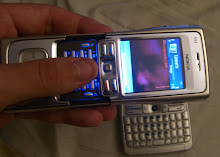newer (faster, more expensive color simputer) - from wikipedia
http://mailman.edc.org/pipermail/digitaldivide/2005-April/002012.html
http://in.rediff.com/money/2003/sep/17spec.htm
http://linuxdevices.com/news/NS3539522586.html
http://linuxdevices.com/news/NS5108992809.html
Slashdot stories back to 2001
http://slashdot.org/search.pl?query=simputer
One could actually write quite a case study on how not to develop and deploy technology in the 3rd world. but spiraling costs, poor time to market, excessive expectations and politics probably play a part.
What does succeed? Well, Nokia has delivered 1 billion cell phones, given their market share historicaly that pegs the number of total phones on the planet at something like 2-3 billion. The nokia 1100 is probably in-line with a technology that can sufficiently penetrate the low end. That's the sub-$50 or sub-$40 mark rather than the sub $100 or $200 mark... Combine that with no costs for in-calls, cheapish sms, and prepaid services in rather small units $1-5-10 incremenets and it's something that a signficant chunk of the urban 3rd world population, can or will eventually be able to afford.
The rural and semi-rural "subsistence africulture economy" in africa and south asia lives a largely cash-free existance, so any price point that involves numbers may be largely meaningless.
There's another meta-level question. What do you get a computer for? We all know what a phone is for... What's a computer for? lots of things obiviously, however before the broad expansion in the internet, penetration of computers into american homes, had stalled out simply because the killer app hadn't arrived for a sgnificant chunk of the population. Spreadsheets, word processing and hobbyist applications drove adoption for most of the 80's, communication and web access drove the next wave, and the deep penetration of computers into the media space is driving another.
Where do devices like the simputer or the $100 pc fit in the scheme of things? One obvious problem that the simputer has beyond all others is local resellers, something cellphone companies and carriers have figured out. Anti-capitalist, grovernment run computer handouts seem like a predetermined failure. Computer adoption has been driven by precieved need and the economics of aquisition. Governments have a responsibility to lay out provisions for the it needs of their citizens, guide the educational process in their schools, and prime the pump when it comes to technology adoption, but that doesn't occur in a vacum.




No comments:
Post a Comment